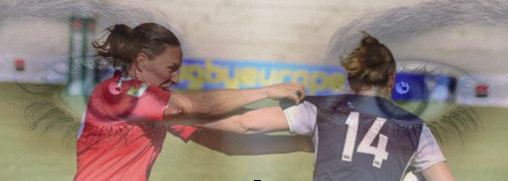What do players see and what should they be looking at?
I talked to one of the players I help after a game where she scored a fantastic try and she says: “I saw everybody moving to the right so I just thought go left, I went for it and scored the try”. Later I looked at the video and tried to see what she saw, but did not recognise the “they all moved to the right”….
So what visual pattern did Sanne recognise that triggered her “go left” response?
We all started talking about visual perception after Clive Woodward brought Sherylle Calder into the mix and she contributed to the 2003 RWC success of England. She is all about working the whole chain:
- Seeing – Looking – Recognising the pattern – Making the decision – Execution of the technique
“If you don’t see something, you can’t make a decision. So one of the skills we work on is being able to see, or pick up, something early. The earlier you see the more time you have to make a decision. That’s a trainable skill.”
“If you make every player make one decision better on the field, that could be 15 or 22 decisions. I said to Clive Woodward in May 2003 that the teams who made the most effective decisions were going to be the ones who win.”
I have read up on her work, trying to understand her perspective on developing players (and like to think I understand).
Why players do what they do
Of course us coaches work to make better players. But remember that we need thinking players because playing the adaptive game is key. Before thinking we need to give them the patterns so they can recognise and select the appropriate response.
Let us take the 2v1 Duel for example. In this basic situation the Ball Carrier has to simply pull the one defender with his running line, time and deliver his pass. He needs to know where his support player is and he needs to be aware of how his defender is moving up on him. He needs to look with peripheral vision. When he sees that his support runner is coming up for the ball and his defender is tied in, he can execute the flat pass.
Now, we can step up and “hide” this 2v1 in “background noise” by making it a 3v2, basically the Duel is still on, but there is more to see: what is the second defender doing?
Is the 3v2 not working? Scale down to the 2v1. This way we can learn our players to recognise the right strike patterns and improve their decision making.
How to translate to rugby?
There is this document circling around on the internet from Paul Tyler, he is a Rugby Development Officer with the Scottish Rugby Union and set up a whole list of exercises you can readily use. Some are based on the example above, some are variations on the SAQ circuit exercises.
And, is not the work of Pierre Villepreux based on developing the cognitive mind of the player? His approach is to present the players a problem to solve. He gives them a pattern – visual clue – a builds the triggers.
Johnny Wilkinson and that dropkick
England needed to score to win the RWC2003 final in the last minute. It is because they learned the pattern and visual clues, they won their own kick-off restart and put Wilko in the perfect position for the kick…
Warming-up
We can carry this principle into the warming-up. I always try to link my warming-up drills with the main topic of my training, so for a training where we work on defensive the work of Paul Tyler has inspired me.
More information on:
- Dr. Sherylle Calder her publications;
- and her now famous Eye Gym, run the free trial;
- Why looking at smartphones does not help;
- The reference to the Paul Tyler document;
- More on SuperCoach Online, my training planner;
- Photo Sanne: courtesy of Rugby Europe;
- The ‘quiet eye’ an article on the BBC website;
